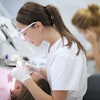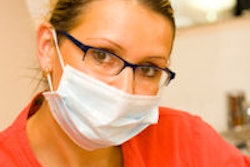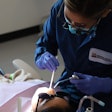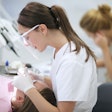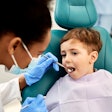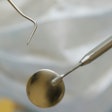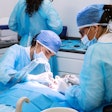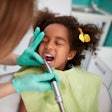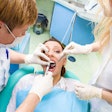
Dental therapists (DTs) can significantly increase access to care in school-based programs and reduce patient costs, according to three studies in the current Journal of Dental Education (JDE). But they would provide only modest savings at federally qualified health centers (FQHCs) and would not increase private practices' net revenues, according to the study authors.
In the first study, researchers from the University of Connecticut reviewed the literature on dental therapists to analyze their economic impact on community clinics and private practices (JDE, August 2012, Vol. 76:8, pp. 1061-1067).
They compared the anticipated savings of DTs, who are expected to be paid about half of dentists' salaries, to physician assistants and nurse practitioners.
"Although the training and roles of dental therapists differ among countries, all dental therapists extend the capacity of dentists, especially in underserved areas, primarily by providing common diagnostic, preventive, and restorative services," the study authors wrote.
Studies on the impact of DTs on the quality of care, patient satisfaction, and practice/clinic finances are limited, they noted. But studies from countries where DTs actually practice report that the majority of the public (57%) would allow DTs to restore their teeth, and patients treated by DTs and dentists were equally satisfied.
However, dental therapists have not boosted the bottom line for private practitioners in the U.K., the researchers noted.
"The limited literature on the impact of dental therapists suggests that they work mainly in school and community clinics and some private practices, are well accepted by patients, provide restorations that are comparable in quality to those of dentists, expand the supply of services, do not increase private practices' net revenues, and in school programs decrease the number of untreated decayed teeth," they wrote.
The major contribution of DTs appears to be in providing dental services to children in school-based dental care systems and community clinics, the researchers added. However, they also have the potential to help address the need for more children on Medicaid to get adequate dental care.
"Of the approximately 33.8 million children enrolled in Medicaid and the Children's Health Insurance Program (CHIP), some 40% now receive at least one annual dental visit," they wrote. "To increase utilization for all children to 60% -- the rate seen in children from upper-income families -- another 6.7 million children need to receive care; dental therapists may help to accomplish that objective."
“Where is their evidence that DTs do not increase private practices' net revenues?”
— Jay Friedman, DDS, MPH
But Jay Friedman, DDS, MPH, a former clinician who has published extensively in professional journals and was a researcher at the University of California, Los Angeles School of Public Health, disputed the authors' conclusions.
"Where is their evidence that DTs do not increase private practices' net revenues?" he told DrBicuspid.com. "This conclusion is based on a theoretical model, not on empirical studies, such as the Canadian DTs in Saskatchewan. It bases this conclusion on a couple of studies done in Great Britain where there are a number of confounding issues, including that most dental therapists in the U.K. have been limited to dental hygiene functions and that the DT has yet to be integrated fully into private practice."
Cost savings at FQHCs
The second study, authored by the same University of Connecticut team, estimated the impact of DTs on the finances and productivity to federally qualified health center (FQHC) dental clinics in Connecticut and Wisconsin (JDE, August 2012, Vol. 76:8, pp. 1068-1076).
Currently, FQHC dental clinics treat approximately 3.7 million people per year, half of whom are children, the study authors noted. Of the 1,200 FQHCs in the U.S. in 2009, some 820 provided dental services and employed 2,500 full-time equivalent (FTE) dentists and 1,120 full-time dental hygienists.
Most FQHCs dental clinics have fewer than five operatories, two or fewer FTE dentists, and fewer than one FTE dental hygienist per dentist, according to the study authors. For FQHCs that provide dental care, dental patients account for about 10% of total FQHC revenues and expenses. In terms of dental clinic revenues, studies show that 41.8% comes from grants, 6.5% from self-pay patients, 6.5% from private insurance, and 45.1% from public insurance (mainly Medicaid), according to the researchers.
For this study, assuming that DTs provide restorative, extraction, and pulpal services to children and that dental hygienists continue to deliver hygiene services, the maximum reduction in costs is about 6%, the researchers found. They attributed the limited impact of DTs on FQHC dental clinic finances to two things: DTs only provide 17% of children services, and dentists are responsible for only 25% of clinic expenses.
In this scenario, all DT services, mainly restorations and extractions, accounted for about 17% of children services, valued at 37% of total children services. Children services accounted for 26% to 37% of total FQHC dental revenues, the study authors said, and dentists' wages amounted to 30% of costs.
Dentists' share of service costs at FQHCs ranged between 17% and 32% with a mean value of 25%, the researchers found. An average of $80 per hour was used for FQHC dentists. Dental hygienists' salaries average $40 per hour, but DTs are expected to be paid more, they noted.
In the long run, cost reductions from using DTs are estimated to be 5.6% in Connecticut and 3.9% in Wisconsin, they noted.
"This study suggests that dental therapists providing care to children within the four walls of FQHCs will have a very modest impact on dental clinic finances and utilization. Specifically, dental therapists will generate a cost reduction of no more than 6% of total children costs," the authors concluded.
A major limitation of this study is that it is not based on empirical information of actual DTs working in FQHCs, they acknowledged.
"The results suggested only modest cost reductions because most children require relatively few dental therapist services and because dentist salaries and fringe benefits only account for about 25% of clinic expenses," the study authors wrote. "Further, because even large clinics do not have enough child patients to employ dental therapists full time, the cost reductions per dentist were a maximum of $10,400 per year."
Cost reductions were based on the difference between DT and dentists' salaries. The study also assumed that DTs received more training than dental hygienists.
"DTs are trained to replace the dentist," co-author Tryfon Beazoglou, PhD, stated in an email to DrBicuspid.com. "Their training is more extensive than that of EFDAs [expanded function dental assistants], dental hygienists, and dental assistants. As a result, their wage rate, in a market economy, is expected to be higher than that of EFDAs, dental hygienists, and dental assistants."
But Dr. Friedman questioned the study authors' calculations.
"They [the researchers] are using the difference in salaries as a percentage of the entire gross expenses of the office, including rent, salaries, supplies, and capitalization costs, and they conclude that it's only a very small percentage of that," he said. "But that's not what you're talking about. You're talking about the difference between the cost of hiring a dentist and a DT. That's not 6%; it's 50%."
Impact of DTs on school-based programs
The third study, conducted by the same research team, found that school-based programs have considerable potential to reduce access disparities, with the estimated reduction in per-patient costs approaching 50% versus providing care in FQHC dental clinics (JDE, August 2012, Vol. 76:8, pp. 1077-1081).
Presently, few school programs provide restorative and other services, the researchers noted. These programs operate with minimal operating subsidy from school systems because they bill Medicaid or CHIP for their services. Medicaid/CHIP-enrolled children are considered regular FQHC patients, and Medicaid/CHIP reimburses FQHCs at their usual per-school-visit reimbursement rate ($150 per visit). In most states, this reimbursement rate is substantially higher than the rates available in fee-for-service Medicaid programs.
Connecticut FQHCs provide care to the approximately 35% of screened children who need restorations and other dentist services. A successful strategy has been to have FQHC-employed dentists provide the services in schools using portable equipment, although this approach has also met some resistance by dental practitioners because of the portable equipment, the researchers noted.
The Connecticut FQHC model costs about $250 per child, they estimated, compared with about $439 for Medicaid children treated in FQHC clinics nationwide.
Assuming a difference of $40 per hour, the maximum possible cost reduction if DTs are used is $80,000, the researchers found. This means a potential cost savings of about 5% if DTs are substituted for dentists.
"The substitution of dental therapists for dentists in school dental care systems has at least two potential advantages: first, a modest reduction in program costs (around 5%) because dental therapists have lower salaries than dentists; and second, it may be easier to recruit dental therapists than dentists to work in schools using portable equipment," the study authors concluded.
But they pointed out that the actual savings will likely to be substantially less for the following reasons:
- The difference in dentist and dental therapist wages may be less than $40 per hour.
- Dentists have to spend some time supervising dental therapists.
- DTs may not have the necessary clinical knowledge and skills to provide all restorative, surgical, pulpal, and other services to patients assigned to them.
Even so, FQHC-operated, school-based dental programs have the potential to increase Medicaid/CHIP utilization from the current 40% to 60% for a relatively modest increase in total expenditures, the researchers concluded.
However, Dr. Friedman questioned why the study authors target an increase in utilization of only 40% to 60%, when school-based programs have been documented to achieve more than 90%, and the authors' assumptions about using dental hygienists in school programs to screen the children and identify those needing restorative treatment.
"This is redundant. DTs cannot only screen the children and determine need for restorative and other DT services, they can also provide the treatment," he said. "An RDH [registered dental hygienist] is not needed in a school that deploys a DT."



